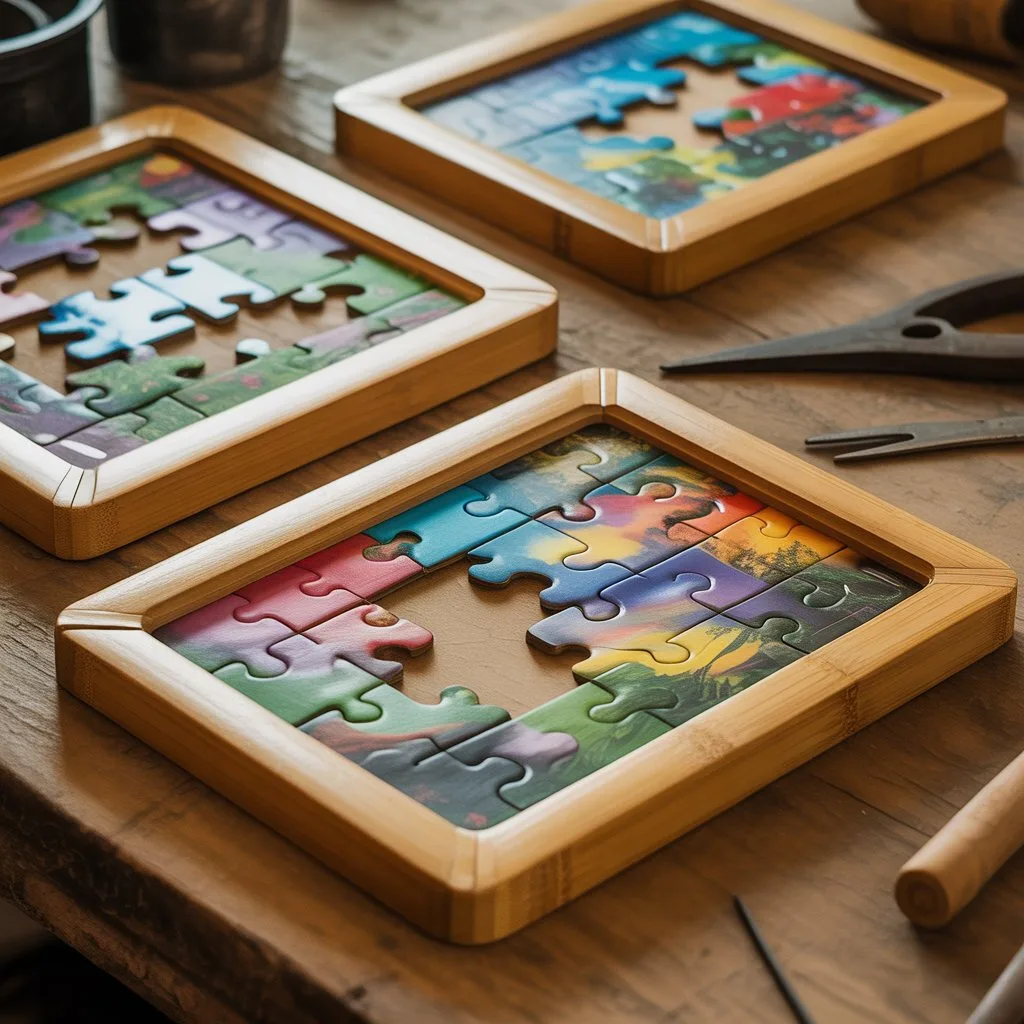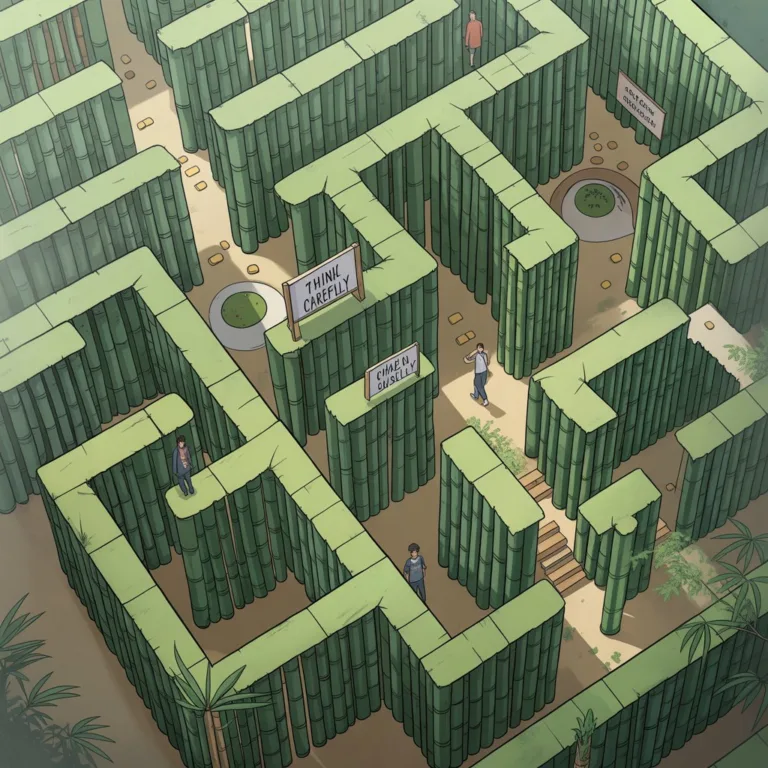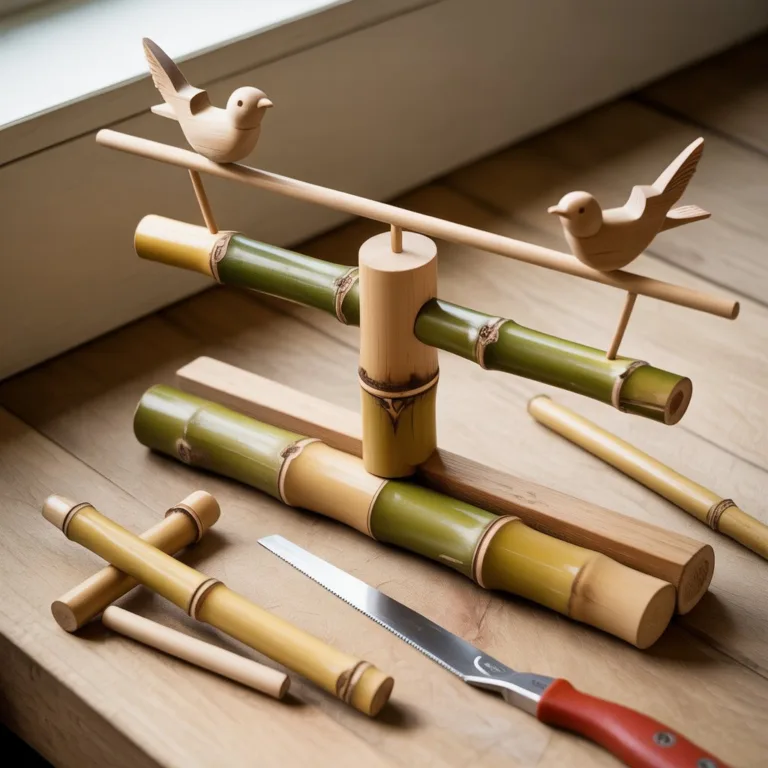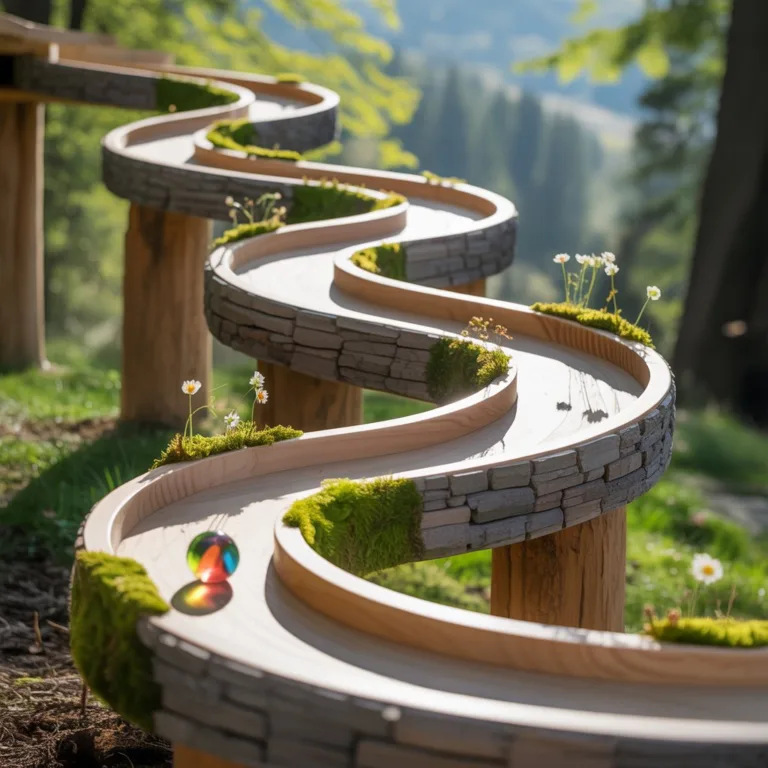Bamboo has long been celebrated for its strength, sustainability, and versatility. In the world of crafts and eco-friendly projects, it stands as a renewable material that blends natural beauty with practicality. When combined with recycled elements, bamboo opens the door to creative innovations that are both environmentally responsible and artistically inspiring. One such project that captures this balance is creating recycled puzzles with bamboo frames — a unique fusion of sustainability, creativity, and playfulness that encourages both learning and environmental awareness.

This project goes far beyond a simple craft activity. It invites makers of all ages to think about reuse, mindful design, and the value of handmade learning tools. Whether you’re an educator, a parent, or a DIY enthusiast, crafting puzzles framed in bamboo brings together tactile experience, aesthetic appeal, and the rewarding process of transforming everyday waste into meaningful creations.
The Beauty of Combining Bamboo and Recycled Materials
Bamboo is one of the most sustainable resources on Earth. It grows incredibly fast, requires no replanting, and naturally regenerates after harvesting. When used as a frame material, bamboo provides a strong and lightweight border that contrasts beautifully with colorful puzzle pieces made from recycled materials such as cardboard, plastic lids, or repurposed wood.
The combination of bamboo and recycled materials creates a project that looks both rustic and modern. The organic texture of bamboo paired with upcycled pieces gives each puzzle a distinctive charm. This harmony between nature and reuse serves as a subtle yet powerful reminder that creativity can coexist with environmental responsibility.
Why Choose Recycled Puzzles with Bamboo Frames?
Making puzzles is not only a relaxing hobby but also a highly educational activity. When built with recycled materials and framed with bamboo, puzzles gain an added layer of purpose. Here are several reasons this project stands out:
- Eco-conscious crafting: By using bamboo and repurposed materials, you minimize waste and promote sustainable crafting practices.
- Educational value: Puzzles help develop fine motor skills, spatial reasoning, and problem-solving abilities in children and adults alike.
- Cultural appreciation: Bamboo is deeply rooted in many cultures as a symbol of strength and flexibility — qualities that perfectly reflect the spirit of DIY sustainability.
- Aesthetic versatility: Bamboo frames give puzzles a refined look, allowing them to serve as both toys and decorative pieces.
- Community engagement: Projects like this can inspire workshops, school programs, and family crafting sessions centered on eco-awareness and creativity.
Gathering Materials Mindfully
Creating a bamboo-framed recycled puzzle starts with thoughtful material selection. Instead of purchasing new supplies, look for items you already have or can source locally from waste or leftover crafts. Here’s what you’ll typically need:
- Bamboo pieces or strips: Preferably from leftover bamboo poles, placemats, or garden stakes.
- Recycled base material: Sturdy cardboard, old puzzle boards, or thin plywood make ideal puzzle surfaces.
- Recycled imagery: Magazines, posters, packaging art, or children’s drawings can serve as the visual theme of your puzzle.
- Eco-friendly adhesive: Choose water-based glue or natural paste to assemble the puzzle pieces.
- Cutting tools: A precision knife or scissors for shaping puzzle pieces.
- Protective finish (optional): Natural beeswax or eco-varnish to protect the bamboo frame.
When collecting your materials, aim for variety in texture and color. This not only enhances the puzzle’s appearance but also teaches resourcefulness — a key principle in sustainable crafting.
Designing the Puzzle Concept
Before starting construction, spend a few moments planning the puzzle’s design. Ask yourself what kind of image or theme will best suit your audience. For children, you might choose colorful, simple shapes or nature-inspired scenes. For adults, geometric patterns or photographic collages can make the puzzle more challenging.
The bamboo frame can define the puzzle’s size and shape. You can make a small square puzzle for a quick, satisfying project or create a larger rectangular piece that doubles as wall art. Some crafters even design irregular-shaped frames — hexagons, circles, or heart shapes — to add artistic flair.
To plan your layout:
- Trace the desired frame shape on your base material.
- Cut the bamboo pieces to match the perimeter.
- Decide how many puzzle pieces you want to include and lightly sketch the divisions.
This stage allows you to balance visual appeal and usability, ensuring that the finished puzzle is both functional and beautiful.
Crafting the Bamboo Frame
Creating the frame requires precision but can be done with simple hand tools. If using bamboo poles, slice them lengthwise to obtain flat strips. Sand the edges carefully to prevent splinters. Arrange the pieces around the border of your puzzle base, adjusting the corners for a snug fit.
When gluing the bamboo to the base, apply minimal adhesive to prevent warping. Bamboo’s natural texture bonds well with eco-friendly glues. For additional strength, you may tie the corners with thin jute string or plant fiber twine — an aesthetic and sustainable detail that reinforces the frame.
Once the frame is assembled, let it dry thoroughly. The result should be lightweight yet strong, with a smooth surface that complements the recycled puzzle design inside.
Creating and Cutting Puzzle Pieces
This part of the process invites the most creativity. Begin by gluing your chosen image or collage onto the base material. Smooth it carefully to remove air bubbles and ensure it adheres evenly. Once dry, outline your puzzle pieces using a pencil or fine marker.
Keep in mind that puzzle complexity can vary depending on the audience:
- Younger children: Larger, simpler pieces with rounded edges.
- Older kids or adults: Smaller, more intricate shapes that increase the challenge.
Use a precision knife to cut along your outlines, separating each piece cleanly. Take your time with this step; smooth cuts ensure the puzzle fits together neatly and lasts longer.
If you want an extra touch of durability, you can coat the finished surface with a natural sealant. This will protect the colors and make the puzzle easier to clean.
Personalizing the Design
One of the joys of making recycled puzzles with bamboo frames is the freedom to personalize. You can paint the bamboo edges, engrave small designs, or burn patterns using a wood-burning pen. For a natural finish, rubbing a small amount of coconut or linseed oil will enhance the bamboo’s golden tone.
The puzzle’s artwork can also reflect personal or local themes — wildlife, community landmarks, or abstract art created from repurposed packaging. Including educational elements, like letters, numbers, or ecological messages, transforms the puzzle into a learning tool.
Some artisans even experiment with multi-layer puzzles, using different recycled materials for each layer. For example, a base layer from cardboard and an upper layer made from recycled plastic or thin wood. This adds texture and visual interest, while reinforcing the idea that discarded materials can gain new purpose.
Using Recycled Puzzles in Educational Settings
Teachers and parents often seek engaging ways to teach sustainability. Recycled puzzles with bamboo frames are ideal for this purpose. They can be used to:
- Introduce topics like recycling, material cycles, and renewable resources.
- Develop fine motor coordination and problem-solving skills.
- Encourage collaboration through group puzzle-solving activities.
- Inspire students to design their own eco-toys.
For classrooms, smaller puzzles work best for group tasks, while larger framed puzzles can serve as interactive wall displays. These can feature environmental messages like “Protect Our Forests” or “Reduce Plastic Waste,” turning learning into a hands-on environmental statement.
Hosting Community or Family Workshops
Hosting a puzzle-making session can bring people together for a shared purpose. Local craft centers, schools, or neighborhood associations can organize recycled puzzle workshops that combine creativity with environmental education.
Participants can bring their own recyclable materials and bamboo scraps, exchange ideas, and leave with a personalized puzzle. This communal approach encourages resource sharing and reinforces the idea that sustainability thrives on collaboration.
Workshops can also be adapted for different age groups. Children can make colorful, simple puzzles from cereal boxes and bamboo placemats, while adults may prefer sophisticated designs with intricate frames.
Sustainable Crafting Practices
Even in creative projects, sustainability should guide every decision. When making bamboo-framed puzzles, consider these responsible crafting practices:
- Use what you already have: Avoid purchasing new materials unless necessary. Repurpose what’s available.
- Choose natural finishes: Beeswax, plant oils, or non-toxic varnishes protect bamboo without harming the environment.
- Reduce waste: Keep leftover bamboo scraps for future projects, like coasters or picture frames.
- Recycle again: If a puzzle becomes worn out, separate its parts — bamboo can be composted or reused.
- Educate others: Share your methods and encourage sustainable crafting in your community.
This approach not only keeps your projects environmentally friendly but also fosters an awareness that creativity and responsibility can coexist harmoniously.
Turning Puzzles into Decorative Art
While puzzles are often seen as toys, bamboo-framed versions can also serve as stunning decorative pieces. When assembled, they can be mounted on walls or displayed on shelves, adding a touch of natural artistry to any space.
You can even design puzzles that double as interactive art — for example, modular wall puzzles that can be rearranged to form different patterns. These combine play, design, and sustainability in one cohesive creation.
For home décor enthusiasts, puzzles featuring natural imagery — forests, animals, or landscapes — framed in bamboo, make perfect eco-friendly decorations that tell a story of reuse and creativity.
A Gentle Reminder Through Craft
Every time you make or play with a recycled puzzle framed in bamboo, you engage in a small but meaningful act of environmental care. These projects remind us that discarded materials are not waste but resources waiting to be reimagined. The bamboo, standing strong and flexible, symbolizes resilience — a perfect metaphor for the sustainable mindset we all need to cultivate.
Whether you gift it to a friend, use it in a classroom, or keep it as an art piece, this project encourages others to look at crafting not just as recreation, but as a mindful way to protect and celebrate our planet.
So the next time you’re surrounded by what looks like waste — bits of bamboo, old magazines, or scrap cardboard — remember that creativity can transform the ordinary into something both beautiful and meaningful.

Elena Mora is a creative educator and eco-craft enthusiast who specializes in bamboo musical instruments and sustainable toys for children. She believes that hands-on learning through play teaches kids about creativity, music, and environmental responsibility.



